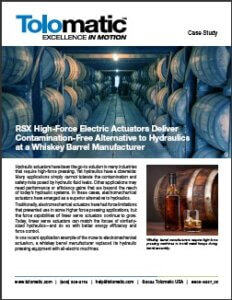Whiskey Barrel Manufacturing Case Study
RSX High-Force Electric Actuators Deliver Contamination-Free Alternative to Hydraulics at a Whiskey Barrel Manufacturer
Hydraulic actuators have been the go-to solution in many industries that require high-force pressing. Yet hydraulics have a downside: Many applications simply cannot tolerate the contamination and safety risks posed by hydraulic fluid leaks. Other applications may need performance or efficiency gains that are beyond the reach of today’s hydraulic systems. In these cases, electromechanical actuators have emerged as a superior alternative to hydraulics.
Traditionally, electromechanical actuators have had force limitations that prevented use in some higher force pressing applications, but the force capabilities of linear servo actuators continue to grow. Today, linear servo actuators can match the forces of similarly-sized hydraulics—and do so with better energy efficiency and force control.
In one recent application example of the move to electromechanical actuation, a whiskey barrel manufacturer replaced its hydraulic pressing equipment with all-electric machines.
The High Forces of Barrel Making
This manufacturer constructs whiskey barrels from oak staves, which are gathered together and bound by a metal ring that is pressed onto the stave bundle. During the manufacturing process, the press indexes down while arms extend from the side, locking the barrel in place. Then, the press pushes tooling against the metal hoop. After the metal ring is applied, the arms expand and the barrel is rotated for the process to repeat once more. Because pressing the metal ring onto the barrel requires a high amount of force, the manufacturer initially used hydraulic presses.
Unfortunately, whenever hydraulic fluid leaked from the system and dripped onto the barrel, the entire barrel had to be discarded. Not only did this reduce product throughput, but the downtime required for repairs also impacted the operation. The manufacturer found an alternative with electromechanical presses as a leak-free solution without sacrificing performance.
Replacing Hydraulics With Electric Actuators
The new pressing system uses two linear servo roller screw actuators that operate in tandem. Each actuator features an alignment coupler that prevents the system from binding as they jointly operate a several thousand pound annular-shaped tooling assembly. During actuation, the tooling is pressed into the metal ring so that it can squeeze around the barrel staves. While the manufacturer chose to replace its hydraulic system with two electric actuators, Tolomatic offers actuators that could have accomplished the same results with a single model.
The barrel manufacturer specified two RSX 15 actuators for the new system, each supplying 17,450 pounds of force. With a combined force of 34,900 pounds, the actuators traveled a stroke length just over 20 inches (508 millimeters).
Motion Profile Improvements
With the previous hydraulic system, the manufacturer had a fairly fast and aggressive motion profile. To match this profile with electric actuators, an internal static oil bath around the roller screw was used to improve heat dissipation and extend the life of the actuator. The electric components matched the cycle speed requirement and optimized the motion profile to accommodate a complex multiple-hoop press. With electric actuators, the manufacturer improved the coordination and efficiency throughout the entire system.
Even though hydraulic actuators provided enough force to meet the manufacturer’s needs, throwing barrels away due to hydraulic fluid contamination and production losses caused by downtime were becoming a problem. The high power density of roller screw actuators allowed the manufacturer to achieve application success and also maintain high throughput.

 Ask an Engineer
Ask an Engineer